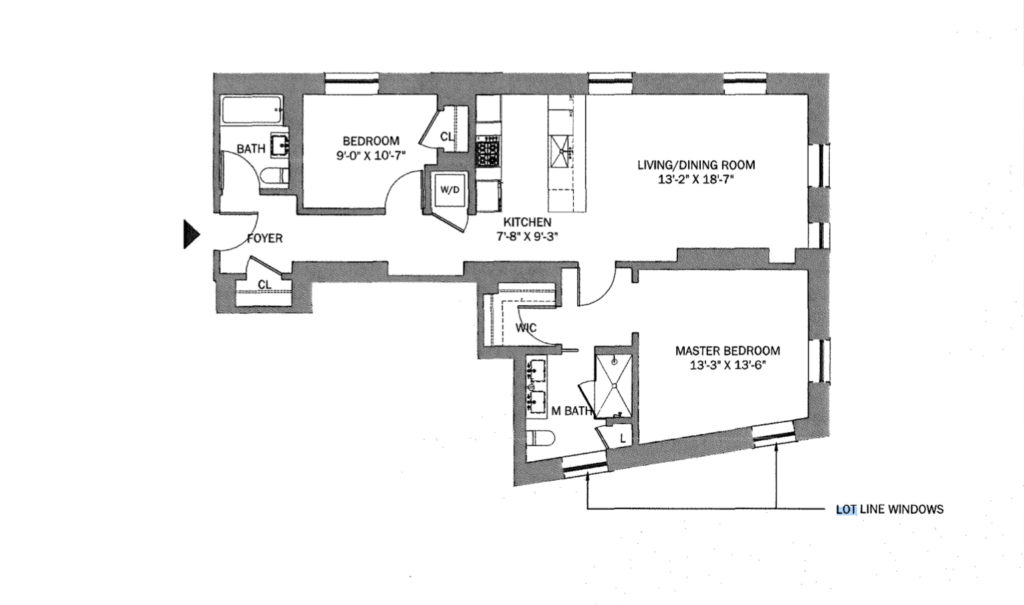A lot line window in NYC is a window that is located on the side of a building which shares a boundary with a neighboring lot. In other words, lot line windows are located directly on the edge of a building’s property line. Light, air and views from lot line windows are not protected and can be lost at any time should an adjacent property decide to build as high or higher than the lot line windows.
Lot-line windows are typically located on one or both sides of a building which stands taller than adjacent structures, or abuts an adjacent lot. Lot line windows are never in the front and rarely in the back of a building.
Here is an example of some lot-line windows in the Chelsea neighborhood of Manhattan:
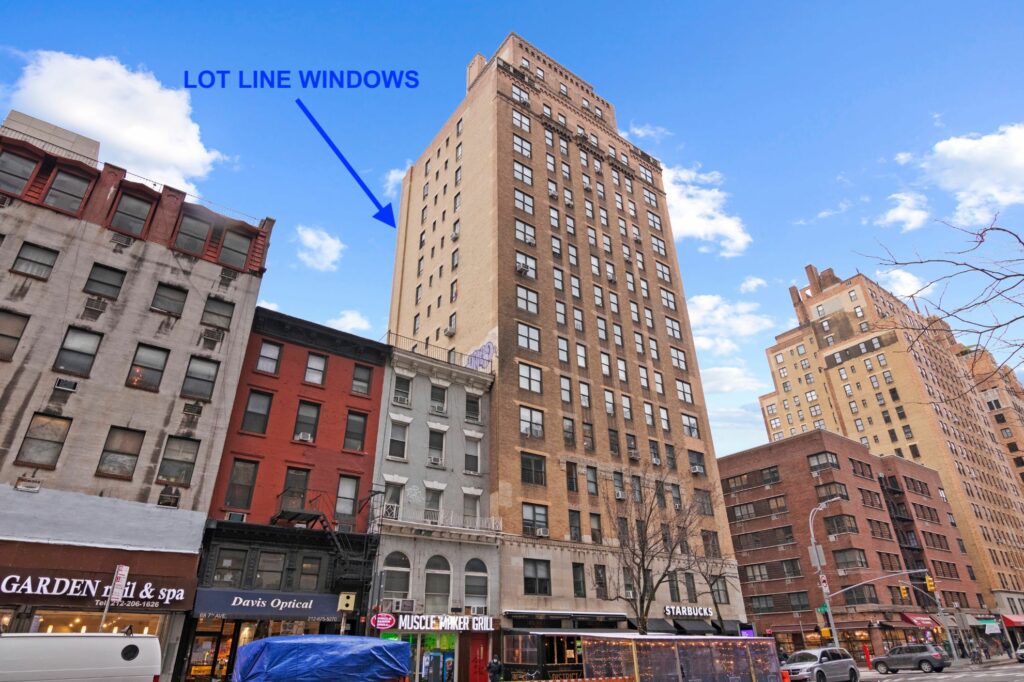
If the adjacent building or lot uses its air rights to build a new structure or add additional stories which are as high or higher than the lot line windows, the owner of the building with lot line windows is typically required by law to ‘brick up’ the affected lot line windows for fire safety reasons. This is because a fire can easily spread to neighboring buildings through a lot line window opening which isn’t properly sealed.
Here is an example of lot-line windows which have been bricked-up, presumably in anticipation of upward development of the adjacent building:
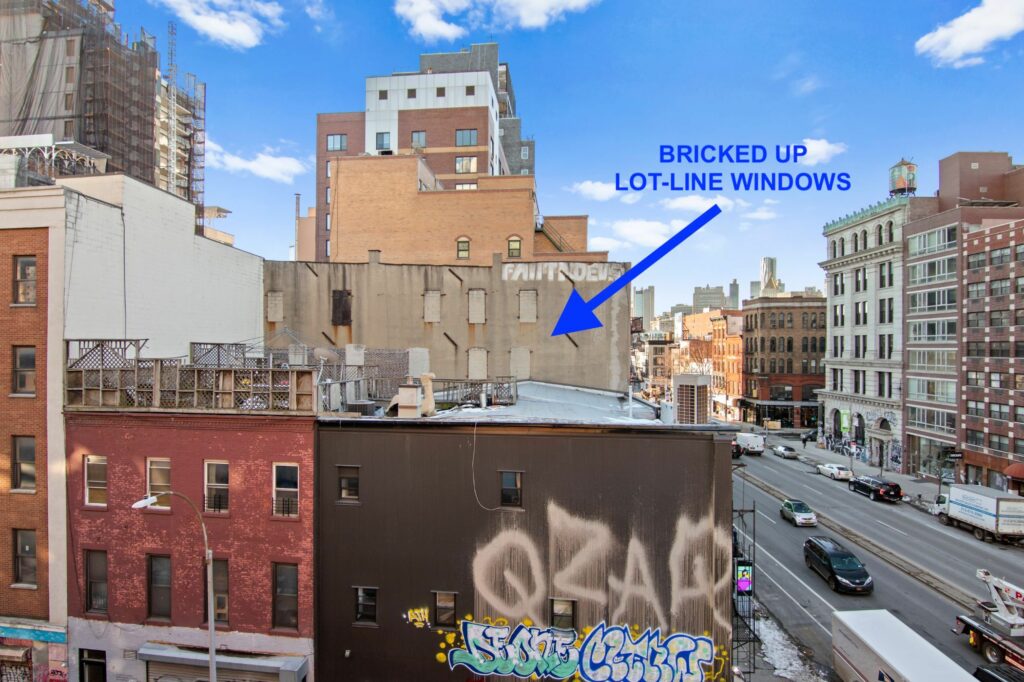
The removal of lot line windows results in considerable loss of light, views and air which adversely impacts the value of a property. In some instances, the removal of a lot-line window can also reduce the legal bedroom count for an apartment, further compounding the potential reduction in market value.
It’s very important as a prospective purchaser to learn which windows might be lot-line and how any future development and subsequent loss of such windows might reduce the value of your investment and impair the quality of life offered by your apartment.
Table of Contents:
What are the chances that my lot line windows will go away?
All lot line windows are not made equal. While some may conceivably remain for decades and practically forever, other lot line windows are high risk and might disappear within just a few years.
Factors to consider when assessing the risk of losing lot line windows include the following:
-
Do adjacent lots / buildings have unused development rights?
-
Is the adjacent empty or underdeveloped lot a condo or co-op?
-
What neighborhood is the empty or underdeveloped lot located in?
-
Is the adjacent building smaller than other structures in the area?
-
How strong is the economy, and is there ongoing development in the neighborhood?
Do adjacent lots have unused development rights?
The first thing to check is whether the adjacent lot/building has unused development rights which would allow them to build higher. To figure this out, we need to learn the following items about the adjacent lot/structure:
-
Lot Area (SqFt)
-
Gross Floor Area (SqFt)
-
Zoning District
-
Floor-to-Area Ratio (FAR)
-
Building Height & Setback Requirements
-
Historic District Information (If Applicable)
The easiest way to obtain information on lot area, gross floor area, zoning district and possible historic district for a lot is by using ZoLa, an interactive zoning and land use map maintained by the NYC Department of City Planning.
Here’s how we would analyze 393 Broadway in Tribeca to determine if future development of this lot/building would put at risk the south facing lot-line windows at 395 Broadway (shown below):
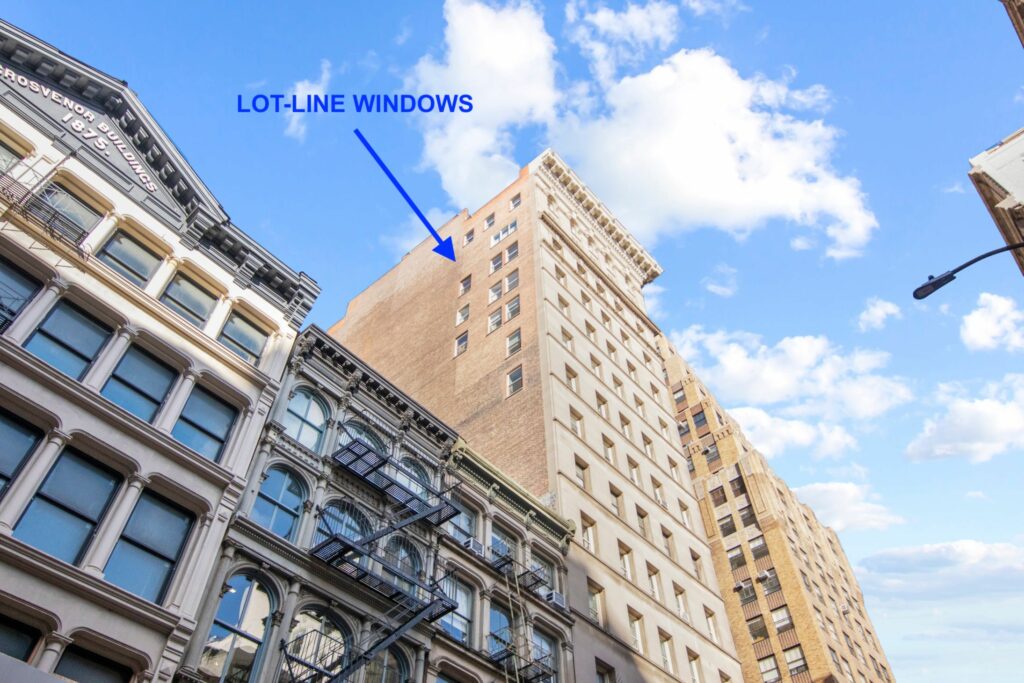
First, let’s look-up 393 Broadway in ZoLa:
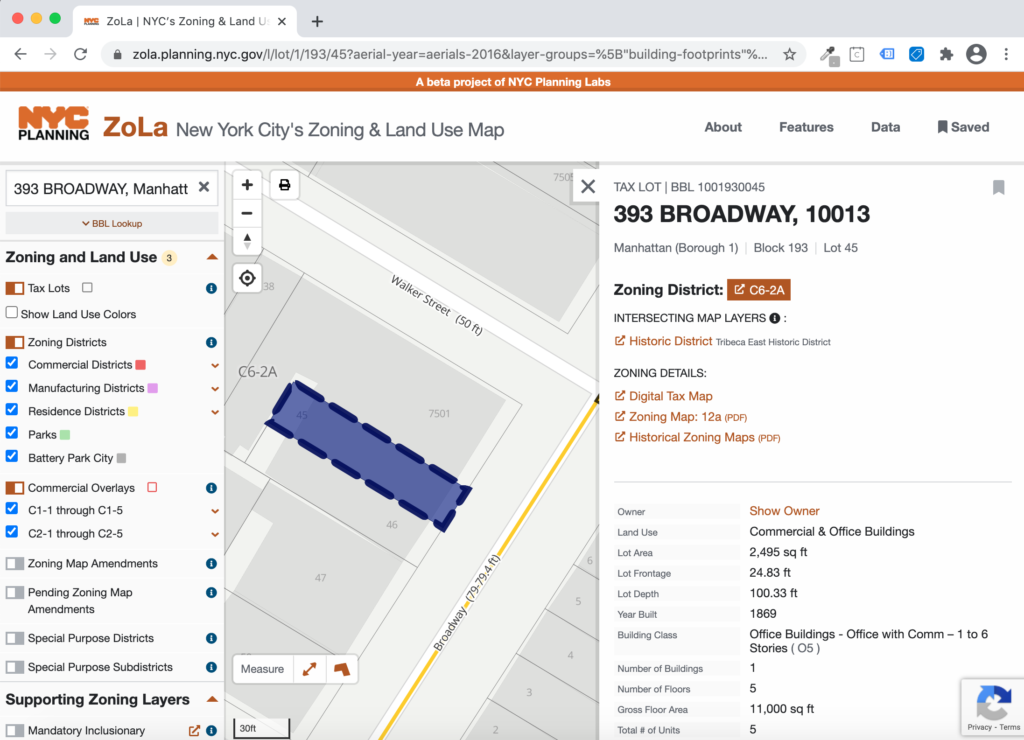
Using ZoLa, we learning the following facts about the tax lot at 393 Broadway:
-
Lot Area: 2,495 SqFt
-
Gross Floor Area: 11,000 SqFt
-
Zoning District: C6-2A
-
Located in the Tribeca East Historic District
The next step is to figure out the permitted Floor to Area Ratio (FAR) in the C6-2A Zoning District. The Zoning Resolution (ZR) of the City of New York determines the extent of permitted development rights for each zoning lot.
By visiting this page, we learn that the C6-2A Zoning District has a ‘Commercial FAR’ of 6. Therefore, the maximum buildable square footage is 6 (FAR) x 2,495 SqFt (Lot Area of 393 Broadway) = 14,970 SqFt.

Since the current gross floor area of 11,000 SqFt is less than the maximum buildable square footage of 14,970 SqFt, we can conclude that this building has unused development rights (air rights) in the amount of 14,970 – 11,000 = 3,970 SqFt.
The number of hypothetical stories which could be added is therefore: 3,970 SqFt (Unused Development Rights) divided by 2,495 SqFt (Lot Area) = 1.6 Stories. However, since the current structure does not cover the entire lot, the owner needs to add more than 1.6 stories to maximize square footage.
From our Zoning Resolution research, we’ve also learned that “C6-2A, C6-3A, C6-3X and C6-4A are contextual districts with maximum building heights.” Further research from this page tells us that the maximum building height in the C6-2A district is 120 feet. There is also a setback requirement which starts between 60′ to 85′:
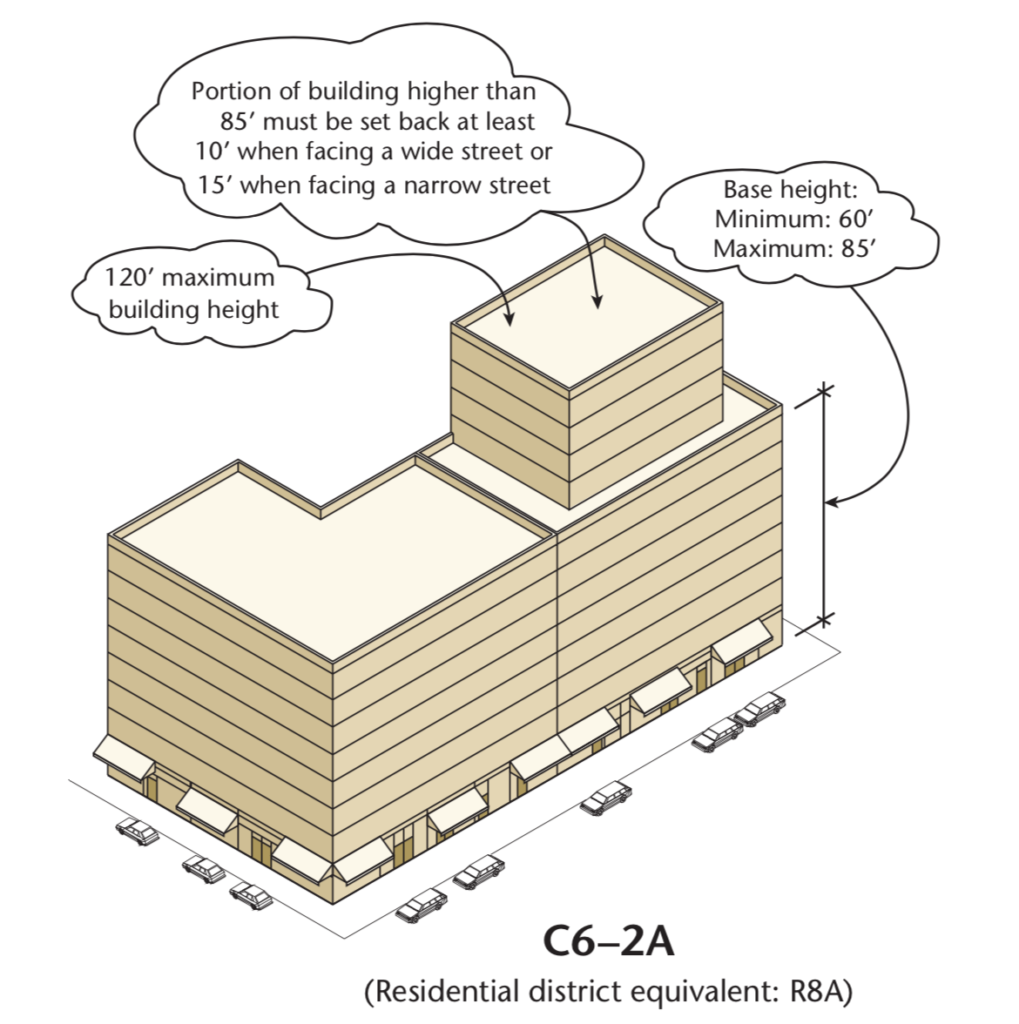
Therefore, any upward development based on our previous Commercial FAR analysis is subject to a maximum building height of 120’ as well as a setback requirement at the front of the building. The setback requirement further reduces available square footage per new floor of upward development, and this means that the building will likely need to add more floors than we otherwise would have anticipated in order to capitalize on all of its unused development rights.
If the owner of 393 Broadway wants to build more square footage than what their development rights permit, the owner may purchase air rights from an adjacent lot.
There are also a few other ways air rights which may be acquired, as we discuss in this article.
Purchasing additional air rights would conceivably allow 393 Broadway to be built up to the maximum height of 120’ (subject to a setback).
Interestingly and perhaps as a result of these building height and setback requirements, the 9th and 10th floors of 395 Broadway do not have as many lot line windows as do the higher floors (11th to 15th), as shown below:
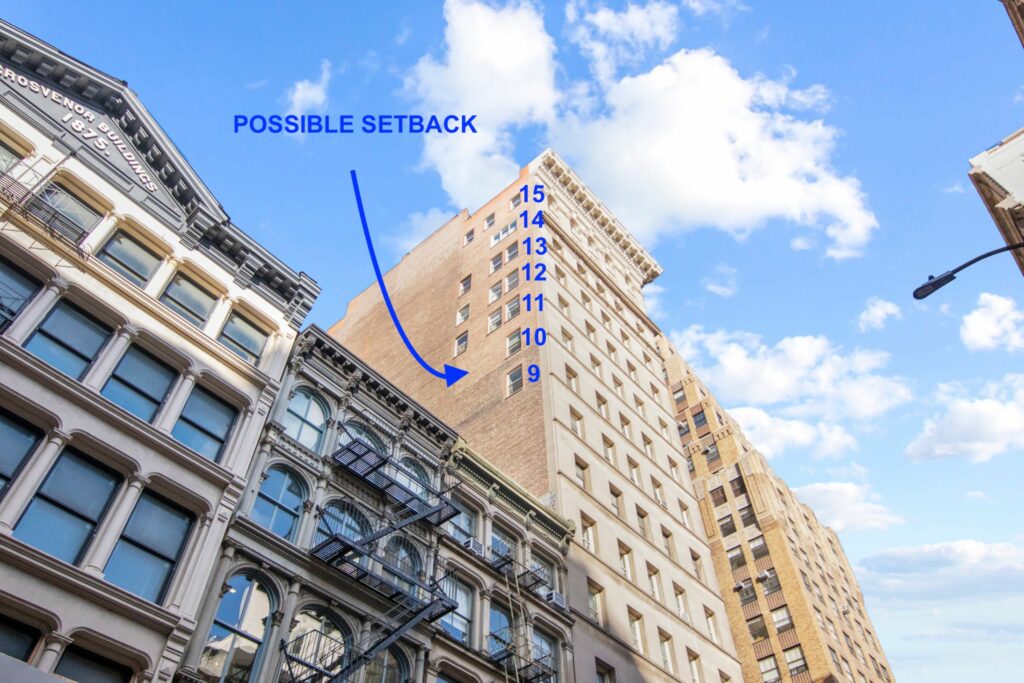
Moreover, using Google Street View, we discovered that most of the lot-line windows at 395 Broadway were added between October 2014 and August 2016. Since the lot-line windows are fairly new and such an installation is very expensive, it’s likely that the owners of these apartments conducted a similar risk analysis of possible future development of 393 Broadway before making the investment in adding these lot-line windows.
All of this strongly suggests, but does not guarantee, that the existing south facing lot line windows at 395 Broadway are not at risk of being bricked up.
If, however, the 9th and 10th floors decided to add a 3rd lot-line window (similar to what higher floors have), these would be at risk if 393 Broadway were to built higher than 85’.
At this point, we’re not quite finished with our analysis. From our earlier zoning research, we also observed that the C6-2A District has a ‘Residential District Equivalent’ of R8A. Although 393 Broadway is in a Commercial Zoning District, the construction of a residential building may still be permitted.
Any such construction would be subject to the zoning regulations of R8A. Therefore, we also need to research the R8A Residential Zoning District.
Further research tells us that the R8A Zoning District has a maximum FAR of 6.02 and a maximum building height of 120’:

The R8A FAR and max building height of 6.02 and 120’ are almost identical to the C6-2A FAR and max building height of 6 and 120’ respectively, as we observe below:
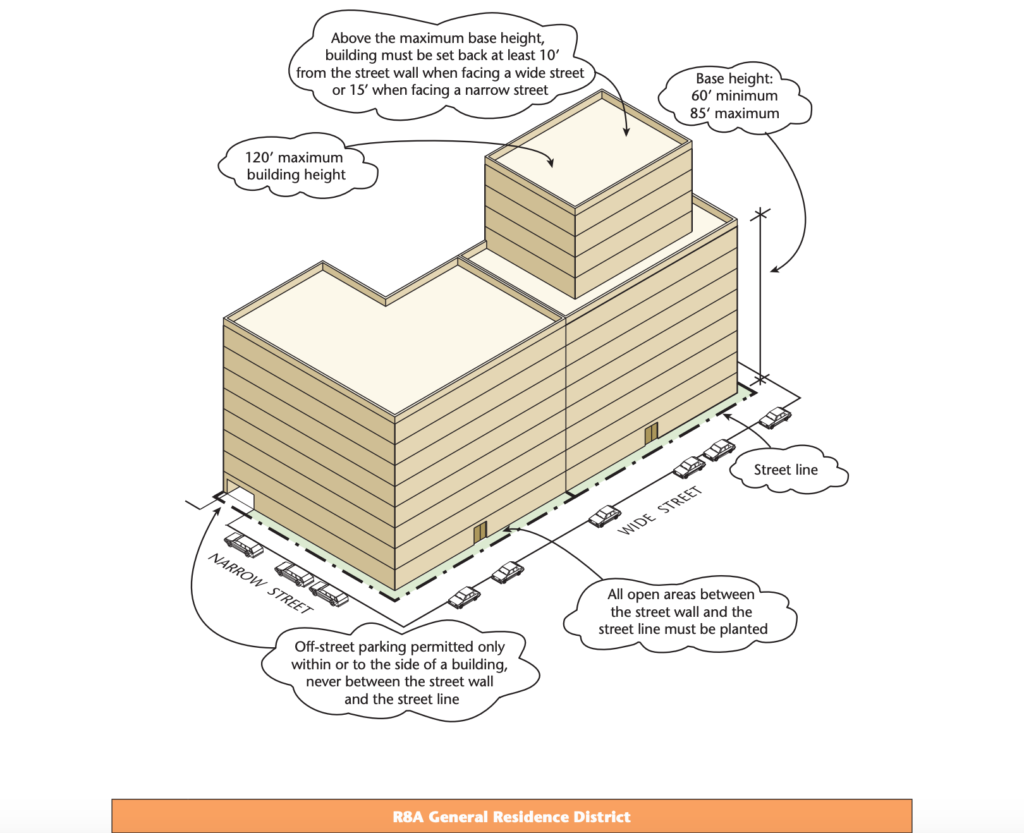
Moreover, the setback requirements for R8A also appear consistent with those of C6-2A.
Before we conclude our analysis, it’s worth pointing out a few other items to consider. Based on the Residential Zoning Data Table (available here), we observe that the maximum building height for R8A may exceed 120 feet in the case of QGF (Qualifying Ground Floor) and QTF with MIH (Mandatory Inclusionary Housing) on a wide street. In either of these scenarios, the max building height could be as high as 125 feet or 145 feet, respectively:
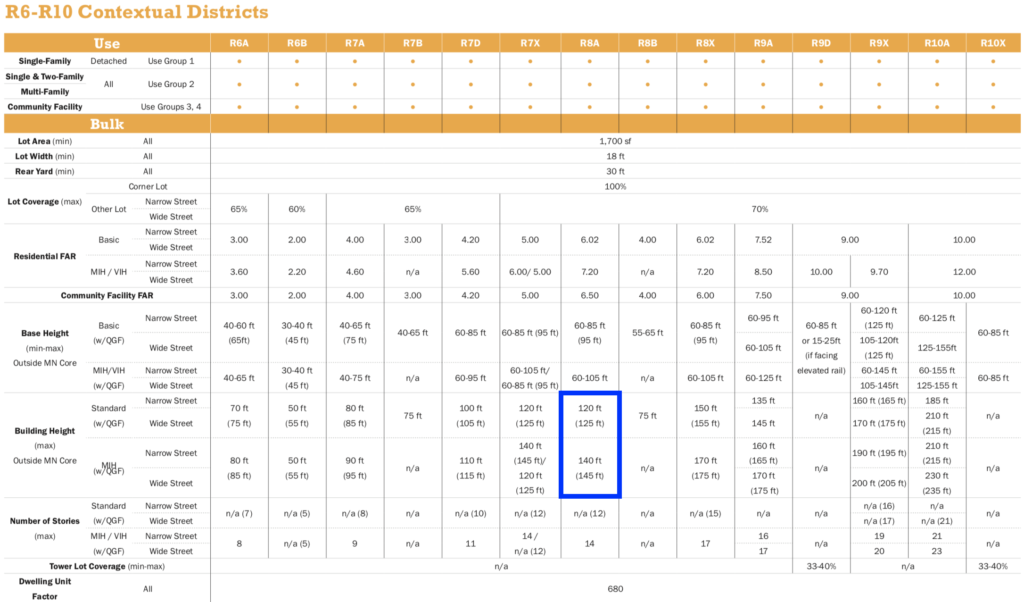
While this additional analysis falls outside the limited scope of this article, it’s something that a zoning professional would need to evaluate as part of a comprehensive risk analysis of these lot line windows.
Is the adjacent empty or underdeveloped lot a condo or co-op?
The primary way to assess the risk of losing lot windows is to research the underlying ownership structure of the adjacent building(s). Is it a condo or co-op building, or a building with a single owner?
In the case of condos and co-ops, the risk of more stories being added is extremely low. This is because most condo and co-ops do not have enough money for development, nor is it likely that existing owners and the Board will actually vote to undertake such a complicated project which is far outside the scope of the normal day-to-day responsibilities of running a condo or co-op building.
When it comes to a condo or co-op building, it’s far more likely that they will sell available air rights to the developer of a nearby lot instead of using the air rights themselves.
If, on the other hand, the adjacent structure is owned by a single person or entity, the risk of future development is high, as there are fewer decision makers.
What neighborhood is the empty or underdeveloped lot located in?
The odds of a structure being built (or expanded) are the highest in the most expensive neighborhoods, such as lower Manhattan, where unused development rights and empty lots are far less common compared to Brooklyn, Queens and The Bronx. Moreover, prime neighborhoods command the highest rents and possible building sell-out values for developers.
In the outer boroughs, where empty lots are much more common, lots often remain empty and undeveloped for long periods of time.
An empty lot will only be developed if the economics make it attractive to do so. In other words, how much money the new building commands in rent (or the total sellout value of the apartments being created) must comfortably exceed the cost of acquiring the lot, building the structure and financing the development.
Is the adjacent building smaller than other structures in the area?
Another way to assess the risk of losing your lot line windows is to look at the size of the adjacent building(s) relative to the size of other buildings in your neighborhood. If the lot is completely undeveloped (perhaps it’s currently a parking lot) or considerably shorter than nearby buildings, the risk of future development is high.
In the case of a small existing structure, the odds of future development are very high. It’s quite common for shorter structures to add many stories as part of a redevelopment, particularly in valuable neighborhoods which have a scarcity of empty lots to build brand new structures.
Here is one such example of upward development of an existing building in Midtown West:
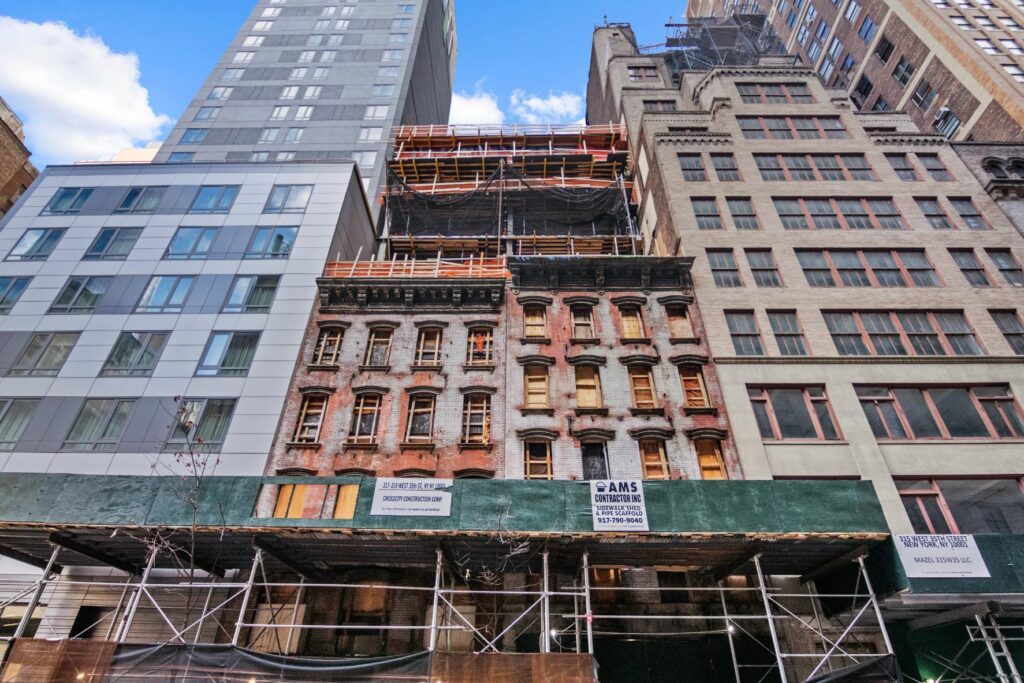
How strong is the economy, and is there other ongoing development in the area?
The likelihood of adjacent development and the loss of lot line windows is greatest when the economy is strong. During periods of market weakness, lower rents and subdued real estate prices reduce the urgency for immediate construction and development.
While they might not actively develop structures during recessionary periods, developers often capitalize on weak markets to acquire land and unused developments rights at more attractive prices for future development.
The odds of losing lot line windows are also greater if there is other active development in your neighborhood. Lots of construction nearby suggests that the overall economics for real estate development in the area are currently favorable. In other words, rents and real estate prices command a sufficient premium compared to the underlying cost of acquiring land, construction, etc.
Yes. It’s possible to permanently protect lot line windows (and views) by purchasing a light and air easement over an adjacent lot/building. Developers of new construction high-rise apartment buildings often purchase the air rights of adjacent lots in order to increase the total sellout value of a project.
When a developer turns a possible lot-line window into a permanently protected window, prospective purchasers are willing to pay more. Having extra permanent windows (as opposed to lot-line windows) may also allow a developer to market an apartment with additional legal bedroom(s), which further increases the market value.
Developers typically try to purchase air rights when the building they’re constructing is located in the middle of a block, sandwiched between two adjacent lots. One example is The Orion, a 60-story condo high-rise at 340 West 42nd Street in Hell’s Kitchen which was built in 2007. In order to preserve the westerly Hudson River views, the developer purchased the air rights from the neighboring buildings on the corner of 9th Avenue and West 42nd Street.
Here is a photo of 350 West 42nd Street, showing the protected air rights on the right side:
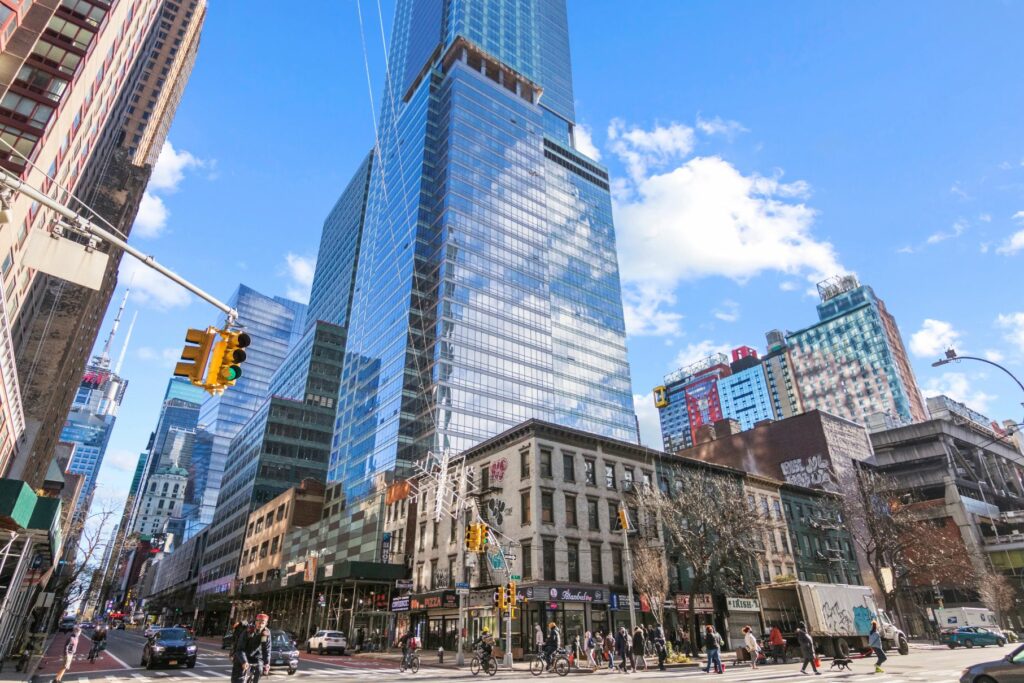
Aside from developers, it’s also possible for existing condo and co-op buildings to purchase adjacent unused development rights in order to permanently protect the light and views from lot-line windows.
One such example is the City Prarire, a luxury pre-war, loft condo building located at 106 Seventh Avenue on the corner of West 17th Street and 7th Avenue. The building has an irregular L-shape lot which means that all of the windows facing the corner are lot-line windows, as shown below:
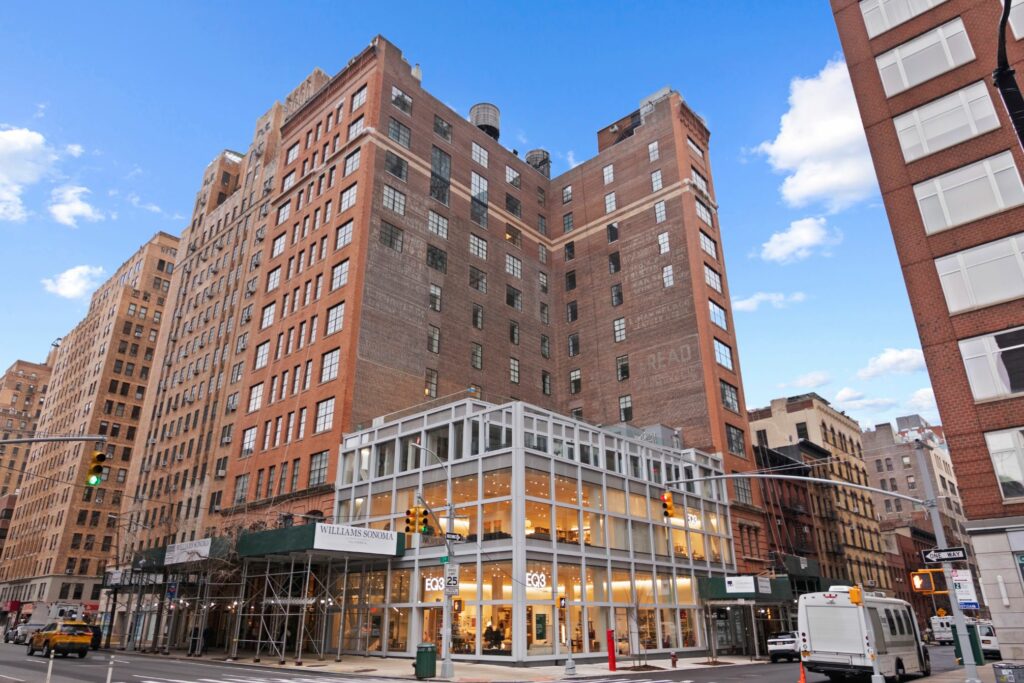
In 2016, Extell Development threatened to build a 145-foot condo directly inside the L-shaped lot of 106 Seventh Avenue, replacing a collection of short buildings which occupied the space. This would have resulted in the complete loss of 8 lot-line windows on each floor of the condo building. For the upper floor units (each of which span an entire floor), this meant the complete evisceration of their cherished Midtown and Empire State Building views.
The condo building eventually paid $11,000,000 to purchase the adjacent air-rights, thereby protecting in perpetuity the light, air and views from the lot-line windows. According to The New York Times, not everyone paid the same amount, with lower floors likely paying far less than the upper floors who benefited disproportionately from the transaction.
The shorter buildings were eventually redeveloped into a new structure which was much shorter than it otherwise could have been if the air rights had not been purchased by the adjacent condo building.
Admittedly, the purchase of neighboring air rights solely to protect views is a rather uncommon occurrence because most condo and co-op buildings can’t afford to do this.
In this unique instance however, with each full-floor apartment being worth $5 to $10 million, buying air rights was financially within reach for the condo building.
It depends. Lot line windows for new developments aren’t always a bad thing. After all, there is no guarantee that a lot-line window will ever go away. If and when it does, you might have enjoyed years or perhaps decades of additional views, light and air.
Moreover, most new development condos are not allowed to utilize lot-line windows to satisfy legal bedroom requirements. This means that you will most likely not lose any legal bedrooms if and when a lot line window is bricked up. In other words, the two bedroom condo you’ve purchased will still be a legal two bedroom apartment if and when you lose that lot line window.
In the unique case of a condo conversion of an existing structure (as opposed to ground-up new construction), it’s possible that a lot line window may be allowed to satisfy legal light and ventilation requirements for bedrooms, kitchens and living rooms. For example, here is the Offering Plan language for a condo conversion which in fact was allowed to use lot-line windows for legal bedrooms:
For ground up new construction buildings, lot windows are often in areas of secondary importance in an apartment. For example, a new development condo might have a lot line window in a walk-in closet or in the powder room. While these windows are obviously nice to have, losing them won’t necessarily be a game changer when it comes to the overall appeal and desirability of your apartment.
Lot line windows for new developments (or condo conversions) are typically disclosed in the ‘Special Risks’ section of a building’s Offering Plan. Here is one such example from the Offering Plan of a condo conversion on the Upper West Side of Manhattan:
Lot-line windows are also typically identified in the floor plans contained in a new building’s Offering Plan. Here is one such example:
